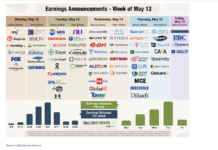Understanding asymmetric risk is critical to making good decisions. Whether you want to be a successful investor, manager or parent, the ability to identify situations where the probability and magnitude of a positive (or negative) result is much greater than the opposite outcome is important. Being able to identify asymmetric risk helps us to steer clear of potentially dangerous situations, where there is little room for error. It also allows us to capitalize on investment opportunities where there are multiple ways to win.
When it comes to my own investing approach, I’m a bit old fashioned. In short, I take a conservative approach in searching for value. I tend to look for companies that are overlooked, misunderstood or out of favor. But the most important characteristic of all, is that they have a high likelihood to once again be fully appreciated or understood by the market (hopefully sooner than later). I particularly like stocks that pay me a nice dividend while I wait, as it represents another way to win while reducing my downside risk. To me, finding great companies at cheap prices with good dividends is the definition of uncovering positive asymmetric risk.
These companies can be fairly easy to find when there is panic in the markets or a market sector. Investors often overreact to a current reality and forecast a future similar to the present. This was the case in 2009. That said, the challenge to find opportunities with positive asymmetric risk has become greater as equity prices have reached historic highs. I believe most of my investments have good risk reward characteristics, but the large majority do not represent potential “home runs.” Fortunately, I was able to stumble upon one of these opportunities in 2012.
The company is Northstar Realty Finance (NRF). I wrote about this stock in two previous blogs (one in 2012 and one in 2013) and various tweets in between. In early 2012, NRF started out as a normal, core holding in my investing portfolio; this meant that it represented 7% to 10% of my overall portfolio. My initial average cost at the time was around $5.50 per share. However, as I learned more about management and their plans to transform the company from a traditional mREIT into “a diversified commercial real estate investment and asset management company that is organized as an internally managed REIT” I became more excited. The potential upside for the company was looking so good that I began accumulating significantly more shares, even as the stock price increased. My conviction in the risk versus reward tradeoff was the highest I have had of any stock I have ever owned. Needless to say, this situation led me to ignore self-imposed position limits. Let’s just say NRF became a large percentage of my portfolio. My conviction around this investment opportunity was based not only on management’s plans to focus on growing the company, but also on a number of factors that supported a positive asymmetric risk profile:
- Complex accounting of CDO’s (collateralized debt obligations) and VIEs (Variable Interest Entities) made the income statement and balance sheet confusing, as such, traditional valuation metrics such as price/book, dividend yield, net income and FFO masked the true value. NRF has recently begun to deconsolidate the CDO’s to add transparency to the business.
- A large and persistent short position, while in some instances can be a red flag, indicated to me that there could be buyers on short term market overreactions to increasing interest rates which would hurt the earning power of traditional mREITs, but not significantly impact NRFs. Secondly, it increased the possibility of outsized gains as shorts would have to cover as NRF turned projections into actual results creating a potential short squeeze.
- Several consecutive dividend increases (currently at 8 consecutive quarters) bolstered by a track record of shrewd capital allocation and increasingly positive earnings conference calls gave me continued resolve and patience that the company was successfully executing the transformation plan. Furthermore, it made me question what potential short thesis could justify paying the increasing dividend.
- Fairly significant price drops on secondary share offerings was another example that the market refused to believe in management´s ability to put new capital to work at a rate of return greater than the total cost of capital. These dilution fears, even in the face of increasing dividends, growing CAD (cash available for distribution) and a lower payout ratio, offered further evidence that the company was mispriced and misunderstood.
- mREIT multiples were being applied to more diverse and stable sources of CAD. In other words less and less of NRF’s cash available from distribution was coming from legacy CDO’s and more of it was coming from equity investments in private equity interests, investments in manufactured housing communities and fees from their growing asset management business. Nonetheless, the market wanted to value all sources of CAD at multiples used for undiversified mREITS. Management, frustrated by the markets unwillingness to recognize the value of current sources of CAD decided to spin off of the asset management business.
- NRF is structured as an internally managed REIT helping to ensure that shareholder and management interests are aligned. Additionally, there is significant insider ownership in NRF which gave me further confidence in management’s willingness to maximize shareholder value.
In summary, every once in a while we are lucky enough to find a stock that the market has overlooked and significantly mispriced. When these investment opportunities present themselves they represent true game changers for your portfolio’s performance and your net worth. Recognizing these opportunities, doing the homework and placing larger bets in situations where there is positive asymmetric risk can lead to outsized gains and keep you well ahead of the indices and traditional performance benchmarks. Thanks for reading.
Twitter: @JoshuaSchroede2
Position in NRF at the time of publication. Any opinions expressed herein are solely those of the author, and do not in any way represent the views or opinions of his employer or any other person or entity.







